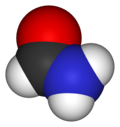Formamide
CH3NO, simplest amide From Wikipedia, the free encyclopedia
Formamide is an amide derived from formic acid. It is a colorless liquid which is miscible with water and has an ammonia-like odor. It is chemical feedstock for the manufacture of sulfa drugs and other pharmaceuticals, herbicides and pesticides, and in the manufacture of hydrocyanic acid. It has been used as a softener for paper and fiber. It is a solvent for many ionic compounds. It has also been used as a solvent for resins and plasticizers.[4] Some astrobiologists suggest that it may be an alternative to water as the main solvent in other forms of life.[5]
 | |||
| |||
| Names | |||
|---|---|---|---|
| Preferred IUPAC name
Formamide[1] | |||
| Systematic IUPAC name
Methanamide | |||
| Other names
Carbamaldehyde | |||
| Identifiers | |||
3D model (JSmol) |
|||
| ChEBI | |||
| ChEMBL | |||
| ChemSpider | |||
| ECHA InfoCard | 100.000.766 | ||
| KEGG | |||
PubChem CID |
|||
| UNII | |||
CompTox Dashboard (EPA) |
|||
| |||
| |||
| Properties | |||
| CH3NO | |||
| Molar mass | 45.04 g/mol | ||
| Appearance | Colorless, oily liquid[2] | ||
| Density | 1.133 g/cm3 | ||
| Melting point | 2 to 3 °C (36 to 37 °F; 275 to 276 K) | ||
| Boiling point | 210 °C (410 °F; 483 K) | ||
| Miscible | |||
| Vapor pressure | 0.08 mmHg at 20 °C | ||
| Acidity (pKa) | 23.5 (in DMSO)[3] | ||
| −2.19×10−5 cm3/mol | |||
| Hazards | |||
| NFPA 704 (fire diamond) | |||
| Flash point | 154 °C (309 °F; 427 K) (closed cup) | ||
| NIOSH (US health exposure limits): | |||
PEL (Permissible) |
none[2] | ||
REL (Recommended) |
TWA 10 ppm (15 mg/m3) [skin][2] | ||
IDLH (Immediate danger) |
N.D.[2] | ||
| Related compounds | |||
Related compounds |
Carbamic acid Dimethylformamide | ||
Except where otherwise noted, data are given for materials in their standard state (at 25 °C [77 °F], 100 kPa).
| |||
Formamides are compounds of the type RR′NCHO. One important formamide is dimethylformamide, (CH3)2NCHO.
Production
Historical production
In the past, formamide was produced by treating formic acid with ammonia, which produces ammonium formate, which in turn yields formamide upon heating:[6]
- HCOOH + NH3 → HCOO−
NH+
4 - HCOO−
NH+
4 → HCONH2 + H2O
Formamide is also generated by aminolysis of ethyl formate:[7]
- HCOOCH2CH3 + NH3 → HCONH2 + CH3CH2OH
Modern production
The current industrial process for the manufacture of formamide involves the carbonylation of ammonia:[4]
- CO + NH3 → HCONH2
An alternative two-stage process involves the ammonolysis of methyl formate, which is formed from carbon monoxide and methanol:
- CO + CH3OH → HCOOCH3
- HCO2CH3 + NH3 → HCONH2 + CH3OH
Applications
Summarize
Perspective
Formamide is used in the industrial production of hydrogen cyanide. It is also used as a solvent for processing various polymers such as polyacrylonitrile.[8]
Reactions
Formamide decomposes into carbon monoxide and ammonia when heated above 100 °C.
- HCONH2 → CO + NH3
The reaction is slow below 160 °C, but accelerates thereafter. At very high temperatures, the reaction products shift to hydrogen cyanide (HCN) and water instead:
- HC(O)NH2 → HCN + H2O
The same effect occurs in the presence of solid acid catalysts.[8]
Niche or laboratory applications
Formamide is a constituent of cryoprotectant vitrification mixtures used for cryopreservation of tissues and organs.
Formamide is also used as an RNA stabiliser in gel electrophoresis by deionizing RNA. In capillary electrophoresis, it is used for stabilizing (single) strands of denatured DNA.
Another use is to add it in sol-gel solutions in order to avoid cracking during sintering.
Formamide, in its pure state, has been used as an alternative solvent for the electrostatic self-assembly of polymer nanofilms.[9]
Formamide is used to prepare primary amines directly from ketones via their N-formyl derivatives, using the Leuckart reaction.
Biochemistry

Formamides are intermediates in the methanogenesis cycle.
Prebiotic chemistry
Formamide has been proposed as an alternative solvent to water, perhaps with the ability to support life with alternative biochemistries to that currently found on Earth. It forms by the hydrolysis of hydrogen cyanide. With a large dipole moment, its solvation properties are similar to those of water.[11]
Formamide has been shown to convert to traces of guanine upon heating in the presence of ultraviolet light.[12]
Several prebiotic chemical reactions producing amino acid derivatives have been shown to take place in formamide.[13]
Safety
Contact with skin and eyes is not recommended. With an LD50 of grams per kg, formamide is of low acute toxicity. It also has low mutagenicity.[8]
Formamide is classified as toxic to reproductive health.[14]
References
Wikiwand - on
Seamless Wikipedia browsing. On steroids.



